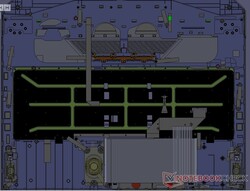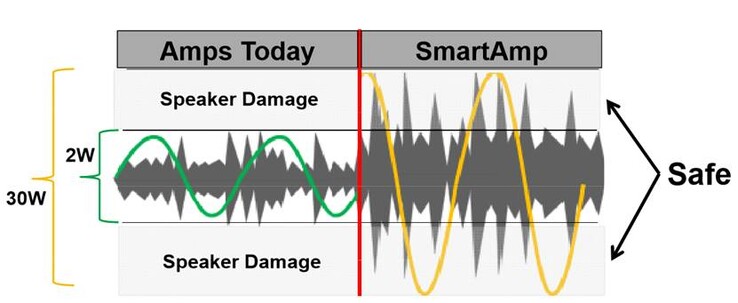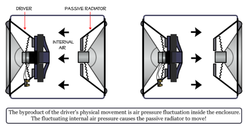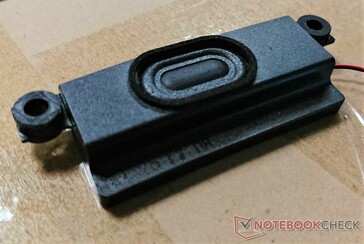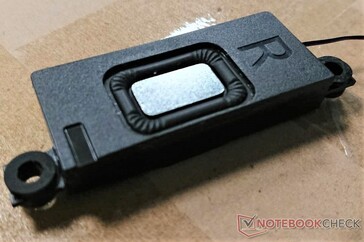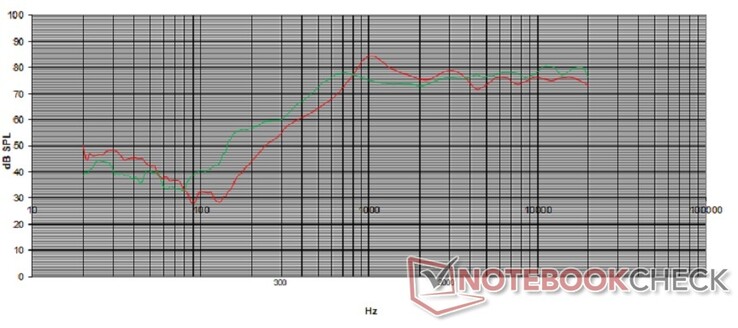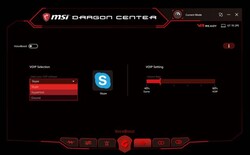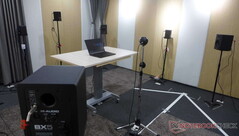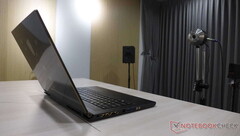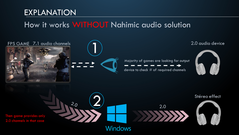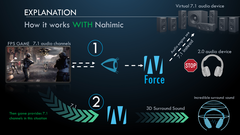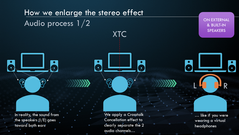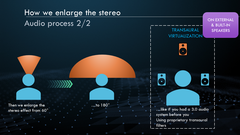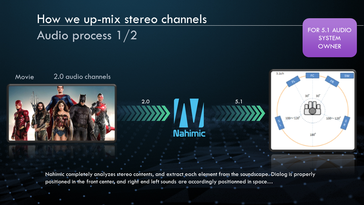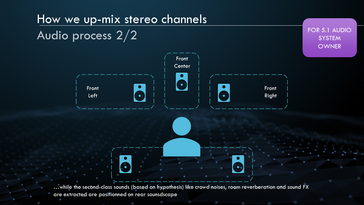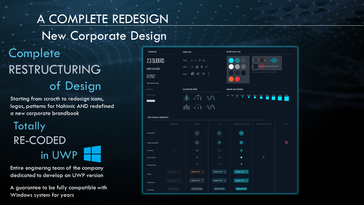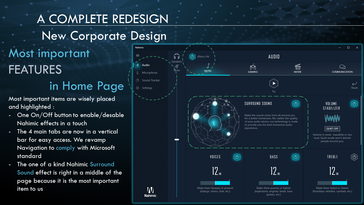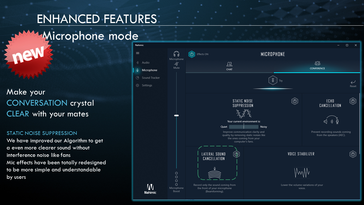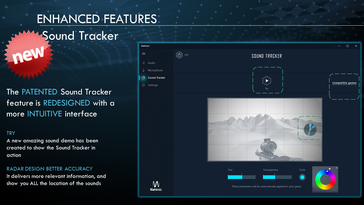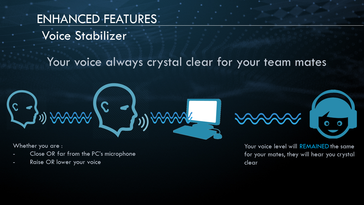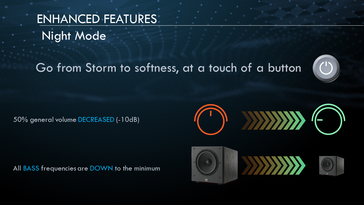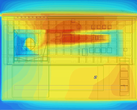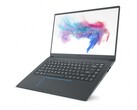Laptops 101: Designing a capable laptop audio subsystem
Introduction
Speakers are often an afterthought in the grand scheme of things during a laptop purchase, with most of the focus being on the CPU, GPU, RAM, storage, and display quality. Most laptop makers offer devices with mediocre tinny speakers knowing that users would anyhow use wired or wireless headphones. Discerning users even go to the extent of using a dedicated USB DAC/Amplifier to get much cleaner sound than what the onboard audio can provide.
Several reasons contribute to the use of mediocre speakers in a laptop, the primary reason being cost-cutting. OEMs tend to save the costs of developing good speakers to put towards other components that tend to impact purchase decisions. The space constraint within a laptop is also another factor. In the never-ending quest for thinness, it becomes all the more difficult to have thumping subwoofers and good mid-range drivers in an average current laptop chassis.
Notebookcheck readers will know that we test out the sound signature as well in our reviews to get an idea about the frequency ranges covered by the laptop's onboard speakers. In this article, we will take a look into how laptop speakers are designed and how they work. We will also look into what goes into delivering good headphone audio and some of the software enhancements that work in tandem with the hardware. We illustrate these by taking examples of sound design in MSI gaming laptops.
Check out our previous Laptops 101 topics below:
Onboard speaker design
You could use headsets or external speakers to get better audio but onboard speakers are still an important consideration during a laptop's design. Factors such as the size and placement of the speaker units, the types of speakers that can be accommodated, the circuit design, and the frequency response play an important role in extracting the best possible audio. Let's have a brief look at each of them.
Deciding on speaker size and placement
Danish company Dynaudio provides some of the finest acoustics technology in the world for a variety of audio applications. Dynaudio-designed speakers provide a more natural sound reproduction than conventional ones. MSI has been working with Dynaudio since 2009 to elevate the audio experience on its gaming notebooks and this collaboration helps in deciding the choice and positioning of speakers during the design stage itself.
Dynaudio pitches-in at a very early stage in the speaker design process. As you can see in the adjoining picture, the speaker size and positions are incorporated into the design blueprint. Important factors to be considered while deciding on the size and placement of speakers include the balancing, resonance, and scope for vibration. Dynaudio engineers look into the speaker positioning and circuit design, and they recommend changes, which are tested in prototype designs before a final call is made for mass production. A laptop has limited space for the speakers to push air, which directly affects the frequency response. Hence, the available space must be utilized to the maximum possible extent to ensure good audio output.
Giant Speaker Design
Typically, most notebooks have one speaker towards each side. While some of the better notebooks can reproduce the mids and highs in an acceptable manner, they struggle with low frequencies. Also, it is not easy to simply incorporate a woofer in such designs as the already thin chassis leaves little room for the cones to move enough air. So the only way to improve audio fidelity and get a near-flat frequency response is to maximize the area available to allow for a pair of woofers and two speakers.
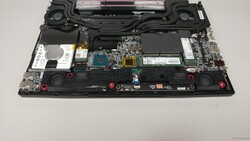
MSI's Giant Speaker Design is one of the ways this is accomplished. As you can see, the bottom quarter of the interior space is dedicated exclusively to the audio subsystem. In this design, we see there is a woofer-speaker pair on either side of the laptop and both are enclosed in fairly large chambers. This allows for a broader frequency reproduction and is a way better implementation than what is found on most conventional notebooks.
Resonance absorption
If you consider the laptop chassis to be a small room, then there is obviously a lot of scope for unwanted resonance and vibration that can affect the output. Using resonance absorbers can dampen the unwanted frequencies quite effectively. In a typical laptop speaker, the resonance absorption material is placed around the main speaker cone to dampen the resonance as much as possible.
Smart Amp Circuit Design
Back during CES 2015, Texas Instruments demonstrated something called a Smart Amp. Put simply, what Smart Amp does is that it allows the speakers to output more power without damaging them. Most laptop speakers are capped at 2 W even though they are theoretically capable of outputting 10 W or even 30 W. This is deliberately done to prevent damage due to excess current flowing through the coil and to avoid clipping artifacts. With Smart Amp, it is possible to dynamically filter out only those specific set of frequencies that cross a safe level instead of the entire waveform.
MSI's Smart Amp implementation allows for up to 30 W of sound output without any speaker damage due to additional voltage and temperature. These parameters can be monitored and adjusted in real-time and only the potentially damaging "spikes" are filtered out. Thus, the speakers can operate at higher power without issues. In space-constrained devices such as laptops, Smart Amp-powered speakers allow for far higher sound amplitude (loudness) than what conventional amplifiers allow for. This means more power for bass as well as for mids and highs.
Improving the low frequency response
Deriving a proper low frequency response is a challenge given the constraints in a typical laptop chassis. To alleviate this problem, passive radiators are used. A passive radiator is just a speaker without the innards. You get the cone, suspension, and the frame sans the electromagnetic apparatus. The advantage of using a passive radiator is that it offers a low frequency response comparable to a much larger bass reflex.
So how does a passive radiator help reproduce audible low frequency effects? Consider the schematic on the right in a sealed enclosure. When the actual speaker driver moves inward and outward in response to the input, it affects the air pressure inside the enclosure. When a passive radiator is placed in front of this driver, the air movement affects the movement of the passive radiator as well. This movement of the passive radiator creates similar low frequency effects to what a bass reflex system does.
Passive radiators can be used not just in woofers but in mid-range speakers as well. They are easy to design as, unlike bass reflex tubes, they do not require tuning — they just need to be designed according to the actual speaker driver. This makes them very effective for use in small speaker enclosures. In the photos below, you can see a typical laptop speaker design for the mid-range frequencies. What we see on the top is actually the passive radiator. The actual speaker driver is seen towards the bottom.
Evaluating the passive radiator's performance shows that its frequency response is comparable to a typical 2514/4 cc micro-speaker of similar dimensions, especially in the low and mid-range. In the graph below, we see that the reference micro-speaker can output a very low frequency of 100 Hz. The passive radiator implementation gets very close to this value and is also very much near to the 1000 Hz peak frequency.
In our own review of the MSI GT76, we found that the frequency response is excellent with a high 90 dB maximum volume. Although it sounded a bit muffled and could do better with the lows and mids, there is no doubt that the GT76 boasts an impressive performance that very few laptops can stake claim to.
MSI GT76 Titan DT 9SG audio analysis
(+) | speakers can play relatively loud (90 dB)
Bass 100 - 315 Hz
(±) | reduced bass - on average 7.6% lower than median
(±) | linearity of bass is average (11% delta to prev. frequency)
Mids 400 - 2000 Hz
(±) | higher mids - on average 7% higher than median
(±) | linearity of mids is average (7.2% delta to prev. frequency)
Highs 2 - 16 kHz
(+) | balanced highs - only 3.8% away from median
(+) | highs are linear (4.5% delta to prev. frequency)
Overall 100 - 16.000 Hz
(+) | overall sound is linear (13.1% difference to median)
Compared to same class
» 16% of all tested devices in this class were better, 4% similar, 79% worse
» The best had a delta of 6%, average was 18%, worst was 132%
Compared to all devices tested
» 10% of all tested devices were better, 2% similar, 88% worse
» The best had a delta of 4%, average was 25%, worst was 134%
MSI GT75 8RG-090 Titan audio analysis
(+) | speakers can play relatively loud (94 dB)
Bass 100 - 315 Hz
(±) | reduced bass - on average 9.4% lower than median
(±) | linearity of bass is average (8.7% delta to prev. frequency)
Mids 400 - 2000 Hz
(±) | higher mids - on average 6.8% higher than median
(±) | linearity of mids is average (8.4% delta to prev. frequency)
Highs 2 - 16 kHz
(±) | higher highs - on average 5% higher than median
(±) | linearity of highs is average (7.8% delta to prev. frequency)
Overall 100 - 16.000 Hz
(+) | overall sound is linear (14.4% difference to median)
Compared to same class
» 25% of all tested devices in this class were better, 6% similar, 69% worse
» The best had a delta of 6%, average was 18%, worst was 132%
Compared to all devices tested
» 14% of all tested devices were better, 4% similar, 82% worse
» The best had a delta of 4%, average was 25%, worst was 134%
Headset audio design
While enhanced audio through the onboard speakers is a good thing to have, most users inevitably use headsets for an immersive gaming experience. Thus, the components involved in headset audio must be of a high quality to get a high signal-to-noise ratio (SNR) and good performance for voice communication.
The key to high SNR
Discerning audiophiles would attest to the importance of having a good circuit design for high-res audio output. A good circuit design ensures minimal signal loss and less static noise for a greatly enhanced listening experience. A lot goes into the actual PCB design as well.
The PCB layout is a very critical aspect of headset audio component design and it helps to spend the extra time to ensure that a good electrical routing is achieved within the limited real estate. While factors such as the PCB stack, size, and onboard components are important variables, the key to a good audio chip performance, as with any PCB, is the ground plane. For those not in the know, a ground plane in a PCB connects the board to the power supply ground. The way in which analog and digital components of the board are routed to the ground plane can make all the difference in audio quality, as proper routing reduces electromagnetic interference and suppresses crosstalk.
While we won't be getting into the nitty-gritty details here, it is considered good practice to not split ground planes in mixed signal PCBs, something that MSI also agrees with. MSI says that its evaluation showed splitting ground planes between analog and digital components in the PCB is not really beneficial, and that the company recommends using only one ground plane for both the components to simplify the PCB design. Also, the number of traces through the ground plane should be as minimal as possible and they should not block the "line of sight" from the audio chip output to the op-amp to reduce total harmonic distortion (THD).
Apart from the ground plane, several other measures also help in getting a much cleaner audio output. These include:
- Short ground connections without shared vias.
- Keeping op-amp feedback paths as close to the op-amp as possible.
- Ensuring every op-amp and audio chip has decoupling capacitance on its power supply right next to the power supply pins.
- Short and clean audio path between the audio chip and the op-amp stage (audio path after the op-amp is not that critical).
- Separating digital circuitry from analog circuitry.
- Using gold-plated audio connectors to minimize signal loss.
Voiceboost
Multiplayer gaming becomes all the more fun when voice-coordinating with other team members. In a conventional setup, the players' voices can get drowned out amid the cacophony of in-game sounds, which can prove to be a strategic disadvantage. Voiceboost aims to alleviate this issue by detecting and prioritizing voice over other app and game sounds. Therefore, team members will be able to hear each other clearly and plan the next tactical maneuver. Voiceboost can be configured directly from MSI Dragon Center software.
Software Enhancements
So far, we've seen what goes into deciding the type of speakers, their placement, and how the audio circuitry is designed to maximize headset audio performance. Quality hardware needs to be supported by equally competent software and this is where audio solutions such as Nahimic come in. In this section, we will have a brief look at how Nahimic enhances the overall audio experience on your existing speaker or headset setup.
Noise cancellation
Delivering good noise cancellation algorithms is an integral part of headset design. Compared to other software audio-processing solutions such as Dolby Digital or Creative SoundBlaster Cinema, Nahimic offers an enhanced ability to add features such as voice level controls, noise gate adjustment, noise reduction, and beam-forming. So even if you are in the middle of a high-paced action game, Nahimic can discern your voice from background noise such as explosions or engine roars. The software is tuned by simulating specific environments in a lab and adjusted for high precision in noise cancellation.
N-Force 7.1-channel virtual surround
Most games (and multimedia software) use the Windows default sound settings to deliver audio. That means if you have a stereo headset and it is configured so in Windows, multi-channel audio will be down-mixed to stereo channels and you will lose out on spatial sound information like an enemy sneaking up behind you, for example.
To circumvent this issue, Nahimic uses a proprietary technology called N-Force. N-Force tricks the game into believing that a 7.1-channel audio device is connected so that the game engine can provide all the encoded channels without down-mixing into stereo. N-Force then feeds this sound information to Nahimic's Head Related Transfer Function (HRTF) algorithms that can determine the positioning of the sound and also add additional 3D effects, resulting in an overall immersive experience. With Nahimic, gamers can take out the guesswork in estimating the positioning of the enemy and be able to gauge the relative position of various sounds in the game.
Stereo widening
Nahimic also offers stereo widening capabilities for a more engaging music and movie experience. Traditionally, on both internal and external speakers, the sound is aimed directly at the listener and covers a 60° envelope around the head. By applying a crosstalk cancellation effect, it is possible to further separate information from the left and right channels, and by using proprietary transaural filters it is possible to widen the stereo effect from 60° to 180°.
While transaural filters help widen the stereo effect, binaural filters help recreate the center channel — where most of the dialogues are encoded in a multi-channel setup — and spatially separate the right and left stereo channels outwards. This creates an immersive effect akin to a 3.0 speaker setup.
Stereo up-mix
Movie connoisseurs will prefer a native multi-channel setup by way of 5.1 or 7.1-channel speakers rather than conventional headsets. 5.1 audio encoded in DTS or Dolby Digital is commonly seen in DVDs and Blu-ray discs. A 5.1 setup can offer proper audio positioning. For example, dialogues usually belong to the center while the left and right channels carry the main track. The rear channels usually play back secondary sounds such as crowd noises, people talking behind the character, or gunshots from behind.
However, these systems are underutilized when the source is just a stereo stream. Nahimic offers the ability to up-mix stereo into 5.1 channels by analyzing the source and separating the audio elements based on its properties. There are some limitations to this and the output is not always as precise as a native 5.1 encode. That being said, stereo up-mix is especially useful when listening to music and movies encoded in stereo using a 5.1-channel setup.
Easy to use UI
An intuitive user interface (UI) helps to better utilize all of the powerful tools Nahimic offers without having to wade through a maze of options. The latest Nahimic UI is made by gamers for gamers keeping in mind their requirements. With Windows 10 1809 onwards, Microsoft has introduced a new driver platform called Declarative Componentized Hardware (DCH) drivers that work better with the Windows UWP platform. Nahimic supports the new UWP platform so it benefits from getting automatic updates and tested compatibility across a wide range of laptop models.
The controls in the new UI are easily accessible along with some nifty features such as static noise suppression, a patented sound tracker feature, and a voice stabilizer. Voice Stabilizer helps maintain the same voice levels irrespective of your distance from the microphone. There's also a dedicated Night Mode to reduce the output by 10 dB so that you don't annoy those around you during those late-night gaming sessions.
Conclusion
In this article, we have touched upon what goes into designing a capable audio subsystem, right from the underlying electronics to the software experience. From the discussion above, one thing is pretty clear — it is not a trivial task to house quality audio components in a thin laptop chassis, and it requires several levels of coordination among all the stakeholders, ranging from components suppliers to the end-user. An improper selection of parts and imprecise tuning can ruin the audio experience and steer users away from the notebook. Even though most laptop users prefer using headsets or external speakers, attention to onboard speaker quality is equally important.
We hope that this primer on laptop audio design was helpful in making some of the concepts clear on this important aspect of laptop purchase. Watch this space for upcoming laptop 101 topics including what goes into determining LCD panel accuracy, touchpad design, and more.
Besides this careful component matching it’s ensured that the latest GeForce RTX Turing graphics are at the centre of MSI laptops. Whether playing blockbuster games like Battlefield V with ray tracing for the very best image quality or working with creative apps like Autodesk 3DS Max, Adobe Premiere Pro and Lightroom or DaVinci Resolve, RTX laptops are true "workhorses" for professionals, students, and gamers. They are perfect for combining leisure and work.


 Deutsch
Deutsch English
English Español
Español Français
Français Italiano
Italiano Nederlands
Nederlands Polski
Polski Português
Português Русский
Русский Türkçe
Türkçe Svenska
Svenska Chinese
Chinese Magyar
Magyar
